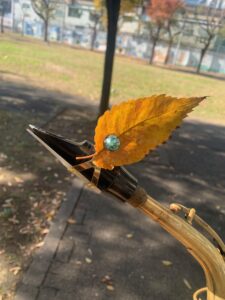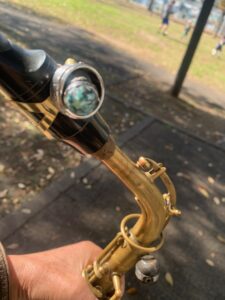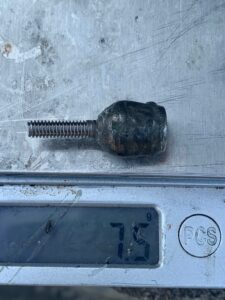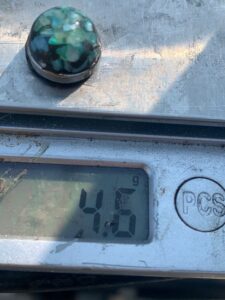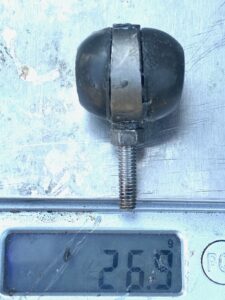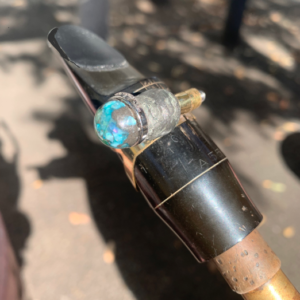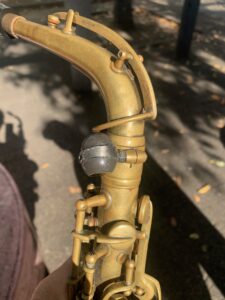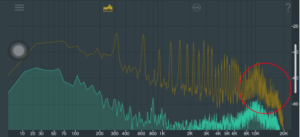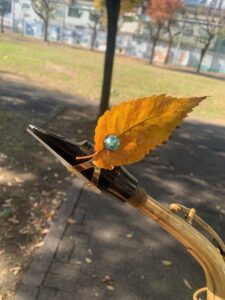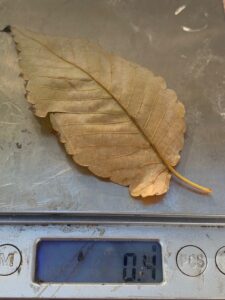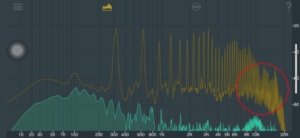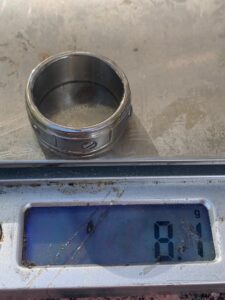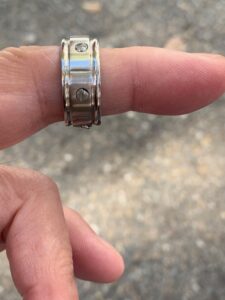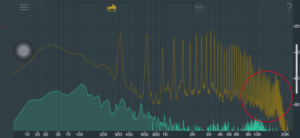Comparative measurement of reed vibration and waveform distribution with soprano saxophone
今回はソプラノサックスでノーマルネックスクリューと、
◯◯◯ブースターネックスクリュー及び、
◯◯◯ブースターより少し重さの少ない制振合金製ネックスクリュー
との比較をします。
In this article, we will compare a soprano saxophone with a normal neck screw, a ◯◯◯◯◯ booster neck screw, and a vibration-damping alloy neck screw that weighs slightly less than the Yanny booster.
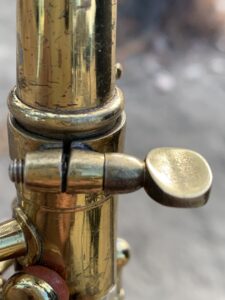

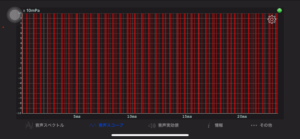
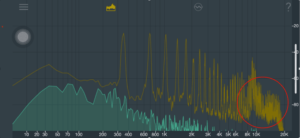
ソプラノサックスをノーマルネックスクリューで下のGの音で測定した。
リガチャーネジもノーマル
The soprano saxophone was measured on a normal neck screw with a lower G tone. Ligature screw is also normal
次に16.4gの◯◯◯ブースター で下のGの音で測定した。
Next, a 16.4g ◯◯◯◯◯ booster was used to measure the lower G tone.
Ligature screw is normal


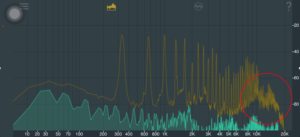
次は15.8gの制振合金製 で下のGの音で測定した。
The next one was made of a 15.8 g vibration-damping alloy and measured with the sound of G below.
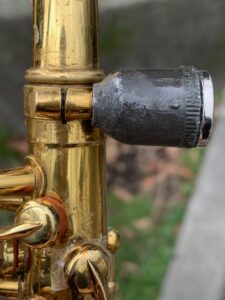

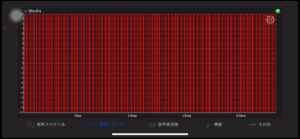
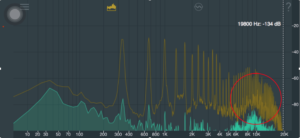
下の測定図は上から下へ、ノーマルネックスクリュー、◯◯◯ブースターネックスクリュー、15.8gの制振合金製ネックスクリューの順で、赤い縦線グラフは1/20秒間でのリード振動数を表しています。この縦線を左から20の所まで計算して、50倍すれば1秒間のリード振動がわかります。因みに、ノーマルでは1秒間/6250回で、◯◯◯ブースターでは1秒間/8000回、15.8gの制振合金製では1秒間/12000回でした。この値は、マウスピース、リード、リガチャーなどが変わるとこの数値も多少変化があります。
The measurement chart below shows, from top to bottom, the normal neck screw, the Yanny booster neck screw, and the 15.8 g damping alloy neck screw, in that order. The red vertical line graph shows the lead vibration frequency in 1/20th of a second. Calculate this vertical line from the left to the 20th place and multiply by 50 to get the lead vibration per second. For reference, the normal reeds vibrate 6250 times per second, the Yanny Booster reeds vibrate 8000 times per second, and the 15.8g damping alloy reeds vibrate 12000 times per second. These values will change slightly as mouthpieces, reeds, ligatures, etc. are changed.
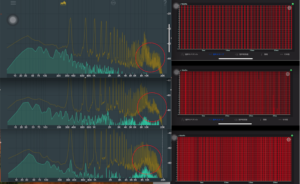
左の振動周波数分布グラフと、右の1/20秒間に振動する周波数を見て
全部同じ音程で音を出していながら右の比較グラフで縦線の違いがあることに、
これを見ているみなさんは気づきましたか?
周波数は、低い音程ではゆっくりと振動して縦線と縦線の間が広く
高い音程では振動が早くなって、縦線と縦線の間が狭くなるのが常識でした。
しかし今回、同じ音程で音を出しているのに、
縦線の周波数の幅が違うということは
リードの振動数が変化したと考えられ、上記グラフのような結果になったわけで
実際、今までよりリードの振動数が増えたことで音の変化や、
楽器の振動が増えたことを
演奏者が一番肌で感じています
この感覚は、例えば50ccエンジンのオートバイが、ワンタッチで
100ccのエンジンや150ccのエンジンに簡単に変身するようなもので、
この150ccのエンジンに変身したオートバイに乗った後に
元の50ccエンジンに戻ると、
全てのパフォーマンスに物足らなく感じるのと似ています。
しかし、この50ccエンジンのパフォーマンスはサックスという楽器が誕生して
以来今まで、素晴らしい良い音として長く聞き慣れた音でした。しかし
本発明の音は、今まで皆さんが経験したことが無い吹奏感であるためこの音を
体現すると、ノーマルにはハッキリと言って戻れないのでは無いでしょうか?
そしてもう一つの特徴は、
楽器から出る音を自分の手で好みの音質に出来ることです。
また、この写真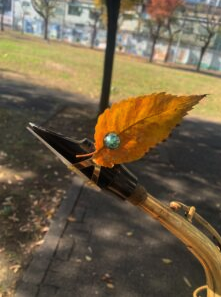 のように本発明のリガチャースクリュー磁石部分
のように本発明のリガチャースクリュー磁石部分
に、葉っぱを付け、ネックスクリューにも本発明のネックスクリューを使用する
と、音がすごく大きくなります。
その状態でベルの中にタオルを入れ音を出した場合、
当然音が小さくなりますが、
吹奏感はノーマル状態で音を出している時の息の量と同じくらいです。
これを弱く小さい音で吹奏しても、音程がしっかり出ているので、
防音設備のない室内で練習するには周りに迷惑をかけず、
音量的に大丈夫だと思います。
Look at the vibration frequency distribution graph on the left and the frequencies that vibrate in 1/20th of a second on the right.
The fact that all the notes are at the same pitch, but there is a difference in the vertical line in the comparison graph on the right,
Did you notice this, everyone looking at this?
At lower pitches, the frequencies vibrate more slowly and the space between the vertical lines is wider, while at higher pitches they vibrate more quickly and the space between the vertical lines is wider.
It was common knowledge that at higher pitches, the vibration is faster and the space between the vertical lines is narrower.
However, the fact that the width of the vertical line frequency was different even though the notes were played at the same pitch this time suggests that the reed’s frequency has changed, resulting in the results shown in the graph above.
In fact, the increase in the frequency of the reeds’ vibrations can be attributed to a change in the sound, or to an increase in the vibrations of the instrument,
In fact, the performer can feel firsthand that the vibrations of the instrument have increased due to the increased frequency of the reeds.
This feeling is similar to that of a motorcycle with a 50cc engine that can be converted to a 100cc engine or 150cc engine with a single touch.
It is similar to riding a motorcycle with a 150cc engine and then going back to the original 50cc engine and feeling that all the performance is not good enough.
However, the performance of the 50cc engine has long been familiar as a great sound since the birth of the saxophone instrument.
However, the sound of this new invention is similar to the sound that everyone has experienced until now.
The sound of this invention is a sound that you have never experienced before, and once you experience this sound, it is hard to go back to the normal sound.
And another feature,
It is that you can make the sound coming out of the instrument to your preferred sound quality by yourself.
Also, as shown in this picture, the ligature screw magnet part of the invention
and the neck screw of this invention, the sound will be very loud.
If you put a towel in the bell and make a sound,
the sound will naturally become quieter,
The sound is about the same as the volume of breath when the bell is played in the normal state.
Even if this is played weakly and at a low pitch, the pitch is still firm, so it is safe to practice indoors without soundproofing without disturbing the surroundings and without disturbing the volume.
最後に、55.3gの重いネックスクリューでどうなるか?と測定して見ました。
これは元々、ステンレス製作業台の4隅にある高さ調節用のネジで、
ネジ径が太かったのを直径4mmに削り、タップでネジを切ったものです。
すごく良い結果が出ると期待していましたが、
以外な結果が!
Finally, what happens with a heavier 55.3 g neck screw? I measured and saw. This was originally a height adjustment screw on the four corners of a stainless steel workbench. The screw diameter was thick, so it was cut down to 4 mm in diameter and threaded with a tap.
I was expecting very good results,
But the result was not what I expected!
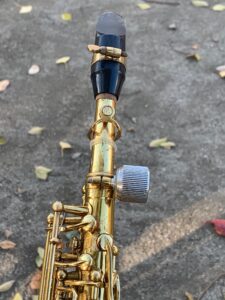

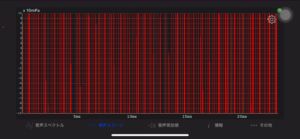
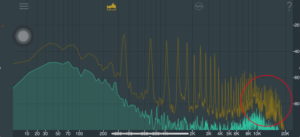
この重いネックスクリューは、楽器が重くなるだけでノーマルと比較してもあまり変わらなく、これは使えない。
This heavy neck screw is not useful because it only makes the instrument heavier and not much different compared to normal.
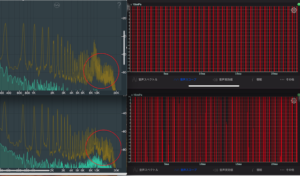
上記の◯◯◯ブースターではリード振動が約1,3倍に増え、これと重量が同じくらいの制振合金製ネックスクリューでは、リード振動が約1,9倍に増えます。制振合金製では低音部での音が全くひっくり返ることなく、今吹いているマウスピース、リガチャーなどのセッティングのままで全音が驚くほど出しやすくなるため、マウスピース、リガチャーなどの高級品を使用することなく練習が楽しみで仕方なくなります。もちろんお金を出して最高のマウスピース、リガチャーなどを使って今より良い音が出たとしても、そこに制振合金製ネックスクリューを付けるとそこからまだ音が良くなります。
With the ◯◯◯◯◯ booster mentioned above, reed vibration is increased about 1,3 times, and with a neck screw made of damping alloy, which weighs about the same as this one, reed vibration is increased about 1,9 times. With the damping alloy, the sound in the bass register is not turned over at all, and all notes are remarkably easier to produce with the same mouthpiece, ligature, and other settings you are currently playing, so you can look forward to practicing without having to use a high-end mouthpiece, ligature, or other expensive products. Of course, even if you pay for the best mouthpiece, ligature, etc. and get a better sound than you have now, you can put a damping alloy neck screw on it and the sound will still improve from there.

